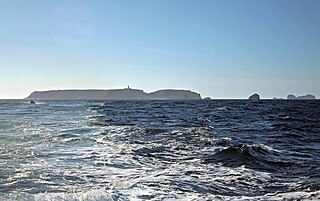
The Berlengas are a Portuguese archipelago consisting of small Atlantic islands 10 to 17 kilometres off the coast of Peniche, Portugal, in the Oeste region. These islands were traditionally known to British mariners as "the Burlings". The only inhabited island is its largest island, Berlenga Grande, although there is currently no permanent habitation in the archipelago. The other islands are grouped into two groups of islets, the Estelas Islets and the Farilhões-Forcados Islets.

Cistus ladanifer is a species of flowering plant in the family Cistaceae. It is native to the western Mediterranean region. Common names include gum rockrose, labdanum, common gum cistus, and brown-eyed rockrose.
The Habitats Directive is a directive adopted by the European Community in 1992 as a response to the Berne Convention. The European Community was reformed as the European Union the following year, but the directive is still recognised.
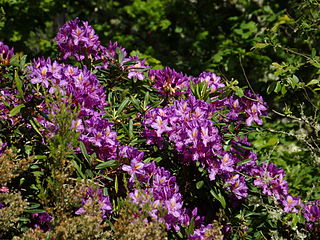
Rhododendron ponticum, called common rhododendron or pontic rhododendron, is a species of Rhododendron native to the Iberian Peninsula in southwest Europe and the Caucasus region in northern West Asia.

Prunus lusitanica, the Portuguese laurel cherry or Portugal laurel, is a species of flowering plant in the rose family Rosaceae, native to southwestern France, Spain, Portugal, Morocco, and Macaronesia.

Herniaria is a genus of flowering plants in the family Caryophyllaceae known generally as ruptureworts. They are native to Eurasia and Africa but several species have been widely introduced to other continents. These are flat, mat-forming annual herbs. The genus gets its scientific and common names from the once-held belief that species could be used as an herbal remedy for hernias.
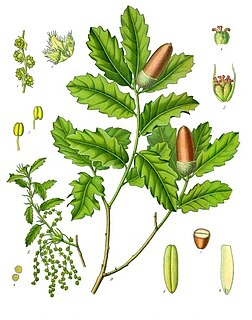
Quercus lusitanica, commonly known as gall oak, Lusitanian oak, or dyer's oak, is a species of oak native to Portugal, Spain and Morocco. Quercus lusitanica is the source of commercial nutgalls. These galls are produced by the infection from the insect Cynips gallae tinctoriae. They are used for dyeing.
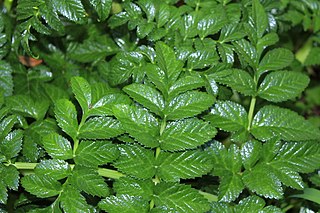
Angelica pachycarpa, the Portuguese angelica, is a herbaceous perennial plant native to north western Spain and western Portugal, and naturalized in New Zealand. It inhabits forests, grasslands and stream sides and is occasionally grown as an ornamental garden subject for its glossy foliage and umbels of white flowers.

Euphorbia stygiana is a species of evergreen shrub in the family Euphorbiaceae, endemic to several islands of the Azores. It has a critically endangered subspecies with only 20 known remaining mature individuals in the wild.

Silene uniflora is a species of flowering plant in the family Caryophyllaceae known by the common name sea campion.

Fritillaria lusitanica is a species of plant in the lily family Liliaceae, endemic to the Iberian Peninsula.

Iris subbiflora is a plant species in the genus Iris, it is also in the subgenus Iris. It is a rhizomatous perennial, from Portugal and Spain in Europe. It has evergreen broad leaves, forming dense clumps, it has dwarf stems in late spring,, with 1 upright fragrant flower, in shades of purple, light red purple, grey-blue, blue-violet, or dark violet. It has a beard which is generally blue, purple, or violet, but can fade to white, dull yellow, or dark yellow. After being found in 1804, it was once a separate species until the late 70s, when it was reclassified as subspecies of Iris lutescens, and renamed Iris lutescens subsp. subbiflora. But in the 80s it was returned to an independent species but some authors and references still class the species as a synonym or subspecies. It is cultivated as an ornamental plant in temperate regions.

Ranunculus bullatus, commonly known as autumn buttercup, is a perennial member of the buttercup family Ranunculaceae, native to Europe and north Africa, including most Mediterranean islands.
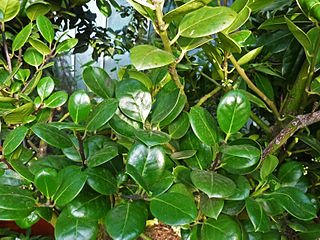
Ilex perado, the Macaronesian holly, is a species of holly endemic to Macaronesia, distributed throughout the Azores, Madeira and Canary islands. It is an important component of the natural high-altitude Macaronesian rainforest, known as 'laurisilva', found mostly at 500 to 1,200 m altitude but it also appears in forest formations at lower altitudes. Many of the subspecies have been classified as threatened, probably because of very small population sizes, and are protected by local, national and regional legislation.

Pulicaria microcephala is a species of flowering plant of the family Asteraceae endemic to the Berlengas archipelago in Portugal. It is a small and ramified plant occurring in clearings of scrubs in coastal cliffs. Its flowers are yellow, flowering between March and July. It is an endangered plant species, mainly threatened by the excessive nitrification of soils and invasive plant species, namely the ice plant.

Culcita macrocarpa, the woolly tree fern, is a species of fern in the family Culcitaceae native to Macaronesia and parts of the Iberian Peninsula, where it might have been introduced.
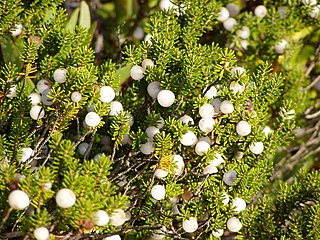
Corema album, the Portuguese crowberry, is a species of flowering plant in the family Ericaceae endemic to the Iberian Peninsula and the Azores, where it may be considered a different species. Its white berries have been consumed by people in the Iberian Peninsula since the Islamic period. The only other species of the same genus is Corema conradii, found in North America.
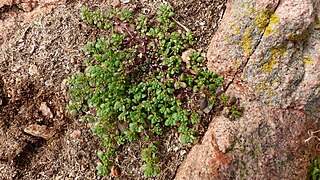
Herniaria lusitanica subsp. berlengiana is an endangered subspecies of flowering plant in the family Caryophyllaceae. It is endemic to the Berlengas Archipelago, Portugal.

Scrophularia sambucifolia is a species of flowering plant in the figwort family (Scrophulariaceae) native to the Iberian Peninsula and Northwest Africa.
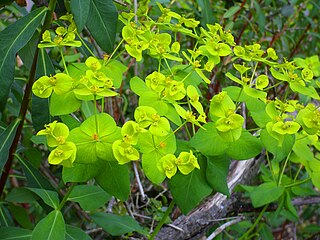
Euphorbia paniculata is a species of flowering plant in the spurge family Euphorbiaceae, native to the Iberian Peninsula and North Africa in the western Mediterranean Basin.



















